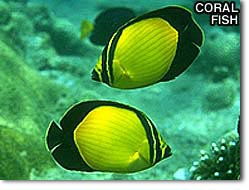CHAETODONTIDAE Butterflyfish, coralfish
 Members of the butterflyfish family have deep compressed bodies and moderate ctenoid (rough) scales. Dorsal and anal fins are well developed and extended. Small protactile mouth with bristle-like teeth. Snout can be extended. With the exception of a few species, such as C. obscurus., butterflyfish are brightly coloured. Chaetodon obscurus dark butterflyfish; Chaetodon melapterus orange butterflyfish; Heniochus acuminatus, pennant coral fish; Chaetodon lineolatus , lined butterflyfish (only off east coast).
Members of the butterflyfish family have deep compressed bodies and moderate ctenoid (rough) scales. Dorsal and anal fins are well developed and extended. Small protactile mouth with bristle-like teeth. Snout can be extended. With the exception of a few species, such as C. obscurus., butterflyfish are brightly coloured. Chaetodon obscurus dark butterflyfish; Chaetodon melapterus orange butterflyfish; Heniochus acuminatus, pennant coral fish; Chaetodon lineolatus , lined butterflyfish (only off east coast).
Dark butterflyfish Chaetodon obscurus
Main body oval shaped, dark brown overall with darker spots on scales forming streaks. Snout paler and pointed. Most common butterfly fish on the east coast where it is found on coral reefs and rocky outcrops. Omnivorous. These pretty little fish are easily observed in shallow water, and are sometimes swimming in large groups, although two or three is the more usual number. Smaller and less colourful than the orange butterflyfish which is the other common species on UAE reefs. 12 cm.
Orange butterflyfish Chaetodon melapterus
Main body oval shaped, bright orange-yellow with head dark purple to black with two orange bands vertically. Pectorals hyaline, others including caudal are dark brown-black, banded exteriorally orange. Found on coral reefs and rocky outcrops. Omnivorous. These colourful butterflyfish are often seen on reefs in pairs, and can be observed by snorkellers, but tend to rush for cover if swimmers approach too closely. Sadly they are often trapped in inshore gargours set among coral reefs, and are discarded by fishermen as being unmarketable. 20 cm.
Pennant coral fish Heniochus acuminatus
Main body oval shaped, with prominent dorsal membrane prolonged in pennant shape. Yellowish colour to second dorsal and caudal fin, with strong vertical dark bars from eye, shoulder and sub-dorsally along the second dorsal fin. Found on coral reefs and rocky outcrops. Omnivorous. Graceful and beautiful fishes, these butterflyfish prefer deeper water, and can often be seen in large groups along the seaward drop-off to coral reefs. 18 cm.